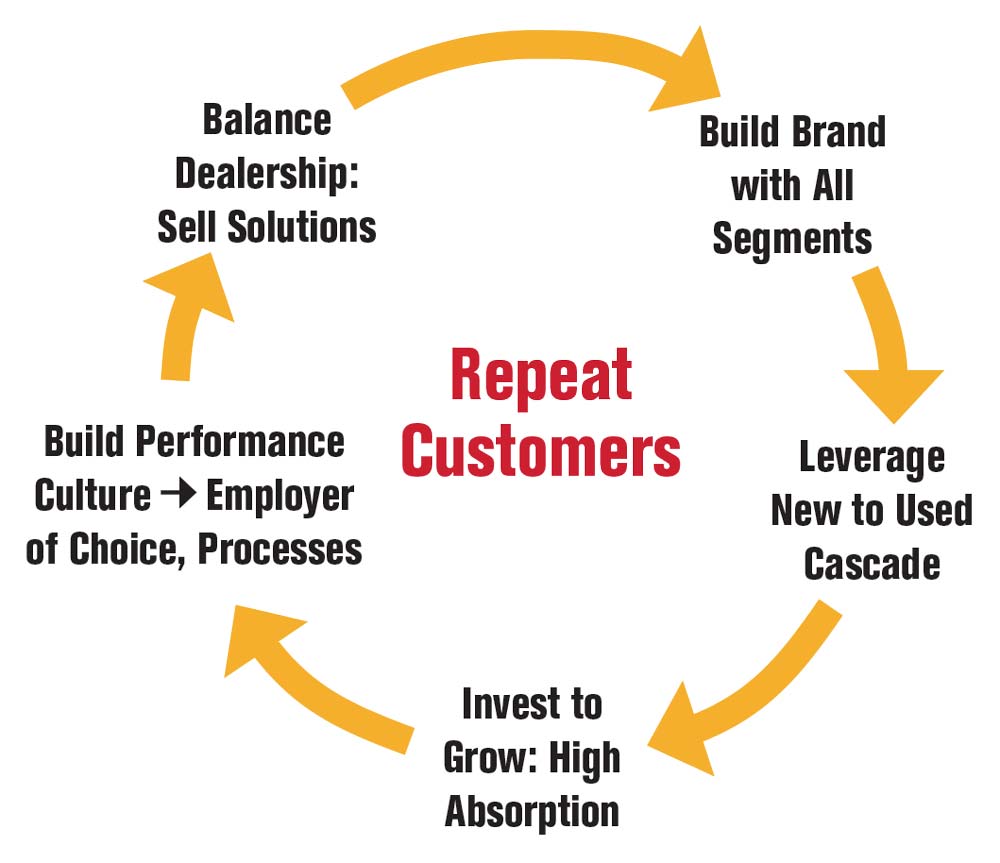What have you learned since the Spring amidst the chaos of COVID-19? As a dealership leader, how will you apply those lessons to position your company to be relevant, sustainable and growing — how will you build your dealership’s momentum to move from good to great?
Early in the Good to Great (G2G) Series, Part 1 of Leveraging Leadership was sub-titled “Coping with COVID-19 – Be Scared and Be Calm” and we wrote:
The rationale of the Good to Great Flywheel is long term sustainability – by that I mean resiliency over the ups and downs of the market, changes in business practices, demographics and other external events. If ever there was a time to have built a ‘Good to Great Dealership’ the COVID Crisis is it.”
In Part II of Leveraging Leadership, we learned how dealerships adapted, in response mainly to COVID, to serve their customers in new ways. Some may be temporary and some will be permanent.
Equally as important, we saw tried-and-true ways to reinforce relationships with customers who actually strengthened their bond with dealerships who kept their needs paramount. We saw dealers who changed their processes and procedures to keep customers safe and productive. Customer of those dealerships saw how you acted, and they liked it.
So, we will pivot in 2021 to focus on what you can do to create and build a culture that puts the customer at the center of your dealership’s “Good to Great Flywheel” and how to do it. We’ll discuss both the vision (“what”) and the actions (“how”) to create a customer centric culture.
The Importance of Leadership to Build Culture
Early in the G2G Series, we explained Spoke #3 which was titled “Build a Strong Culture & Leverage Vital Processes.” The key quote from this article has been replayed to me by dealers who took this lesson to heart:
“Culture eats strategy for breakfast.”
We made this statement personal with another quote.
“So goes the leader, so goes the culture.
So goes the culture, so goes the company.”
Thus, the Leadership Lessons in 2021 to create a customer centric culture go in this order
Leader ‡ Culture ‡ Company ‡ Customer
To make this most definitive, the ultimate objective is ‘Repeat Customers.’ Why? In our performance coaching, we define two high-level objectives for a dealership:
Repeat Customer, and
High Return on Assets
Number 2 is a financial measure and reflects that you run an asset-intensive business. But because …
“…Nothing starts until a sale …”
… Number 1 is, well, Number 1. Selling a customer once is a great start, but selling them again (and again, and again) is the ultimate objective.
So the first Leadership Lesson is to define ‘Repeat Customers’ as the objective for everyone in your dealership. As a leader, build on your culture to make certain that all elements of the Good to Great Dealership flywheel focus on ‘Repeat Customers’ as the objective. Put that clear and aspirational objective at the center of your vision and your actions.
As the theme for Leadership Lessons in 2021, our articles will fall into Whats and Hows.
The Whats – Envisioning the right measures
for successes.
“You can’t change
what you don’t measure.”
The Hows – The actions necessary for results — processes, policies, people and coaching.
Both are needed — vision and action — as a Japanese proverb says:
“Vision with Action is a Daydream.”
“Action without Vision is a Nightmare.”
Here are examples of what to anticipate for each Leadership Lessons article in the year ahead.
Vision: The ‘Whats’ to Create a Customer Centric Culture
- A new definition of ‘Repeat Customers’
- How to measure customer retention
- Why I hate customer satisfaction but love a satisfied customer
- Defining Uptime
- How many machines are under contract to try to fix-before-failure
- Set the operating cost for the customer’s fleet
- Define End to End Cycle Time
- Lowering the time from machine failure to getting paid for the repair
- Helping your customer and your dealership, i.e. lower WIP, higher retention
Action: The ‘Hows’ Lesson to Createa Customer Centric Culture
- The elements of the Customer Service Process
- Learn of Failure: Take the call
- Consult: Determine need, write the work order
- Production: Complete the repair
- Delivery: The last step to ensure a quality repair
- Follow-Up: Will customer buy again?
- Customer Retention starts with Employee Engagement
- Who really pays your paycheck? Employees often forget who pays them
- What to do to increase employee engagement
- How to balance Acquisition or Retention
- Catch and keep vs. catch and release
- Repeat customers are far more profitable than new customers
As we turn to the new year, we look forward to stimulating you to think about the Four Cs – Creating a Customer Centered Culture.







